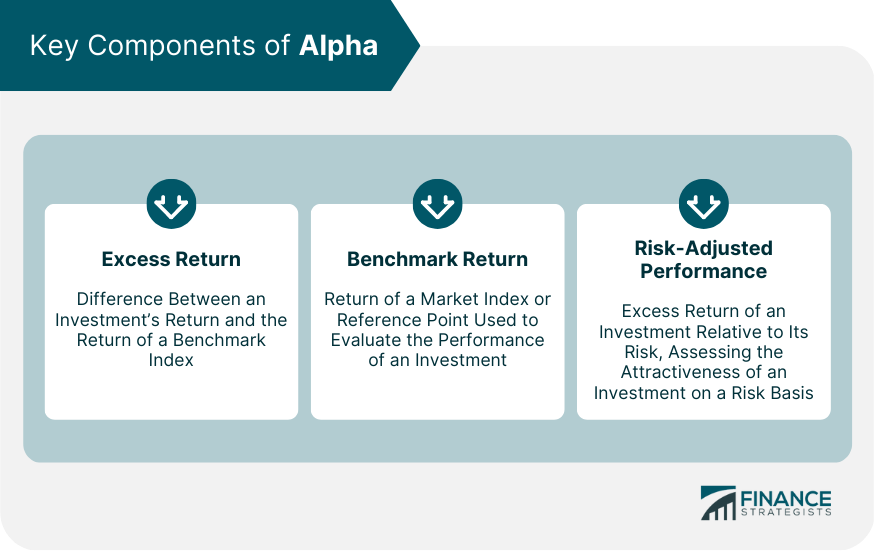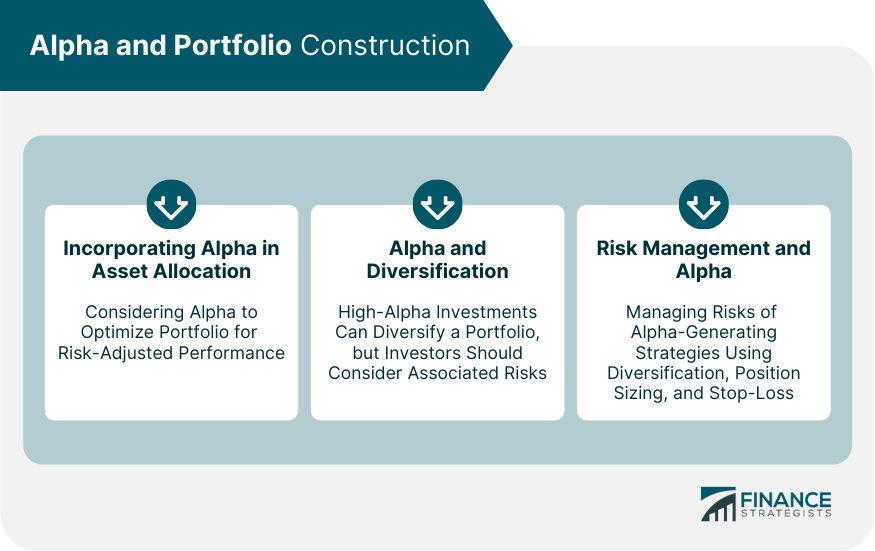Alpha is a measure of the excess return of an investment relative to a benchmark index, taking into account the risk of the investment. In wealth management, alpha is an essential performance indicator that helps investors assess the value added by active management strategies and make informed investment decisions. Alpha plays a crucial role in wealth management, as it helps investors determine whether an investment is outperforming its benchmark and generating value for their portfolios. By understanding and analyzing alpha, investors can optimize their portfolios and achieve better risk-adjusted returns. Alpha is a key metric in investment performance evaluation, as it measures the ability of a portfolio manager or investment strategy to generate excess returns relative to the market. A positive alpha indicates that an investment has outperformed its benchmark, while a negative alpha suggests underperformance. Excess return is the difference between an investment's return and the return of a benchmark index. It represents the additional return generated by an investment relative to the market. Benchmark return is the return of a market index or other reference point used to evaluate the performance of an investment. Common benchmarks include the S&P 500, the Dow Jones Industrial Average, and the MSCI World Index. Risk-adjusted performance measures the excess return of an investment relative to its risk, helping investors assess the attractiveness of an investment on a risk-adjusted basis. Security selection involves identifying individual stocks, bonds, or other securities that are expected to outperform the market. Portfolio managers use various techniques, such as fundamental analysis and technical analysis, to select securities with the potential to generate alpha. Market timing is the practice of making buy or sell decisions based on predictions of future market movements. Successful market timing can generate alpha by capitalizing on market inefficiencies and capturing gains from mispriced securities. Passive management strategies, such as index funds and exchange-traded funds (ETFs), seek to replicate the performance of a benchmark index and do not attempt to generate alpha. However, these strategies can still play a role in wealth management, as they provide diversification and cost-effective exposure to various asset classes. Hedge funds are investment vehicles that employ a variety of strategies, such as short selling, leverage, and derivatives, to generate alpha. While hedge funds can potentially deliver high returns, they also carry higher risks and fees compared to traditional investments. Private equity investments involve buying ownership stakes in private companies with the aim of improving their performance and selling them at a profit. Private equity can generate alpha by unlocking value in underperforming businesses or identifying and investing in high-growth opportunities. Real estate investments, such as direct property ownership, real estate investment trusts (REITs), and real estate crowdfunding platforms, can generate alpha through capital appreciation and rental income. These investments can also provide diversification benefits and hedge against inflation. Alpha is calculated by subtracting the benchmark return from the investment's excess return and adjusting for risk. This can be achieved using various performance metrics, such as Jensen's alpha or the information ratio. A positive alpha indicates that an investment has outperformed its benchmark on a risk-adjusted basis, while a negative alpha suggests underperformance. Investors can use alpha to evaluate the effectiveness of active management strategies and identify high-performing investments. Alpha measurement has several limitations, including the choice of an appropriate benchmark, the impact of fees and expenses on returns, and the assumption of a linear relationship between risk and return. Additionally, alpha is a historical measure and may not be indicative of future performance. By considering the alpha generated by different investments, investors can make more informed asset allocation decisions and optimize their portfolios for risk-adjusted performance. This may involve allocating more capital to high-alpha investments or rebalancing the portfolio to maintain the desired risk-return profile. Investments with high alpha can help diversify a portfolio by providing exposure to different sources of return. However, investors should also consider the risk associated with high-alpha investments and maintain a balanced portfolio that aligns with their risk tolerance and investment objectives. Managing risk is crucial when pursuing alpha, as high-alpha investments may also carry higher risks. Investors can use various risk management techniques, such as diversification, position sizing, and stop-loss orders, to manage the risks associated with alpha-generating strategies. Jensen's alpha is a risk-adjusted performance metric that measures the excess return of an investment relative to its expected return, given its level of risk. A positive Jensen's alpha indicates that an investment has outperformed its benchmark on a risk-adjusted basis. The information ratio is a performance metric that measures the excess return of an investment relative to its benchmark, divided by the tracking error, which is the standard deviation of the excess return. A higher information ratio indicates better risk-adjusted performance. The Treynor ratio is a performance metric that measures the excess return of an investment per unit of systematic risk, as represented by its beta. A higher Treynor ratio indicates better risk-adjusted performance. The Sharpe ratio is a widely used performance metric that measures the excess return of an investment per unit of total risk, as represented by its standard deviation. A higher Sharpe ratio indicates better risk-adjusted performance. Investors often perceive alpha as a measure of investment skill, which can influence their expectations and investment decisions. However, it is essential to recognize that alpha is a historical measure and may not be indicative of future performance. Overconfidence can lead investors to overestimate their ability to generate alpha, resulting in excessive risk-taking and potential losses. To overcome this bias, investors should maintain a disciplined investment approach and focus on risk-adjusted performance. Investors can overcome behavioral biases by employing systematic investment strategies, such as dollar-cost averaging and rebalancing, that help reduce the influence of emotions on investment decisions. In wealth management, alpha plays a crucial role in identifying investment opportunities that can generate excess returns relative to the market. Investors can use various tools and techniques, such as financial analysis, technical analysis, and quantitative models, to identify high-alpha investments. Balancing alpha and risk is essential in portfolio management, as high-alpha investments may also carry higher risks. Investors should maintain a diversified portfolio that aligns with their risk tolerance and investment objectives and periodically review and adjust their portfolios to optimize risk-adjusted performance. Investors should ensure that their pursuit of alpha aligns with their overall investment objectives, such as capital preservation, income generation, or capital appreciation. By focusing on risk-adjusted performance and aligning alpha with their investment goals, investors can improve their overall investment outcomes and achieve their long-term financial objectives. Generating consistent alpha over time can be challenging, as market conditions and investment opportunities change. Additionally, the ability of a portfolio manager or investment strategy to generate alpha in the past does not guarantee future success. Investors should regularly evaluate the performance of their investments and make adjustments as needed to maintain their desired risk-return profile. Fees and expenses can significantly impact the net alpha generated by an investment, particularly in the case of active management strategies and alternative investments, which often have higher fees than passive investments. Investors should carefully consider the fees and expenses associated with different investments and strategies when making investment decisions. The efficient market hypothesis (EMH) suggests that all available information is already reflected in asset prices, making it difficult to consistently generate alpha through active management. While there is ongoing debate about the validity of the EMH, it underscores the importance of diversification and risk management in the pursuit of alpha. Alpha is a critical measure of investment performance in wealth management, as it helps investors assess the value added by active management strategies and make informed investment decisions. By understanding and analyzing alpha, investors can optimize their portfolios for risk-adjusted performance and achieve their financial goals. To generate and manage alpha effectively, investors should employ a disciplined investment approach, focus on risk-adjusted performance, maintain a diversified portfolio, and regularly review and adjust their portfolios based on changing market conditions and investment opportunities. As technology and financial innovation continue to advance, new methods and tools for analyzing alpha may emerge, further enhancing the ability of investors to generate and manage excess returns. These innovations may include machine learning algorithms, advanced data analysis techniques, and more sophisticated risk management tools that can help investors better understand and manage alpha in their portfolios. By staying abreast of these developments and incorporating alpha analysis into their investment strategies, investors can better navigate the complexities of financial markets and achieve their long-term financial goals.What Is Alpha?
Key Components of Alpha
Excess Return
Benchmark Return
Risk-Adjusted Performance

Generating Alpha
Active Management Strategies
Security Selection
Market Timing
Passive Management and Alpha
Alternative Investment Strategies
Hedge Funds
Private Equity
Real Estate
Measuring Alpha
Calculation of Alpha
Interpretation of Alpha
Limitations of Alpha Measurement
Alpha and Portfolio Construction
Incorporating Alpha in Asset Allocation
Alpha and Diversification
Risk Management and Alpha

Alpha and Performance Metrics
Jensen's Alpha
Information Ratio
Treynor Ratio
Sharpe Ratio
Behavioral Aspects of Alpha
Investor Perception of Alpha
Overconfidence and Alpha
Overcoming Behavioral Biases
Role of Alpha in Wealth Management
Identifying High-Alpha Investment Opportunities
Balancing Alpha and Risk in Portfolio Management
Aligning Alpha With Investment Objectives
Challenges and Limitations
Persistence of Alpha
Fees and Expenses
Market Efficiency
Conclusion
Alpha FAQs
Alpha is a financial term used to describe the excess returns generated by an investment portfolio, beyond the returns of a benchmark index. In wealth management, Alpha is used as a measure of a portfolio manager's skill in creating a portfolio that can outperform the market.
Alpha is calculated by subtracting the expected return of a portfolio, based on its beta and the market's expected return, from its actual return. A positive Alpha indicates that the portfolio has outperformed the market, while a negative Alpha indicates underperformance.
An investor can use Alpha to evaluate the performance of their investment portfolio relative to the market. A positive Alpha indicates that the portfolio is outperforming the market, while a negative Alpha indicates underperformance. An investor can also use Alpha to compare the performance of different portfolio managers.
Alpha is not a perfect measure of a portfolio manager's skill, as it does not take into account the risks taken to achieve the excess returns. Additionally, Alpha can be affected by factors outside the control of the portfolio manager, such as market volatility and macroeconomic events.
A portfolio manager can increase Alpha by making strategic investment decisions that can generate higher returns than the market. This can involve identifying undervalued securities, using advanced investment strategies, and actively managing the portfolio to take advantage of market opportunities. However, it's important to note that taking on more risk may also increase the likelihood of underperformance.
True Tamplin is a published author, public speaker, CEO of UpDigital, and founder of Finance Strategists.
True is a Certified Educator in Personal Finance (CEPF®), author of The Handy Financial Ratios Guide, a member of the Society for Advancing Business Editing and Writing, contributes to his financial education site, Finance Strategists, and has spoken to various financial communities such as the CFA Institute, as well as university students like his Alma mater, Biola University, where he received a bachelor of science in business and data analytics.
To learn more about True, visit his personal website or view his author profiles on Amazon, Nasdaq and Forbes.











